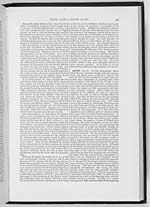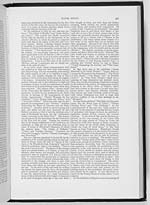324
tools thrown away, and the palette pressed to his
heart. But he did not confine himself to aspira-
tions merely; on the contrary, he accompanied them
with that laborious diligent practice for which his
life was distinguished to the close. Having asso-
ciated himself with the young lovers of art with
whom Edinburgh even already had begun to abound,
he formed with them the Life Academy in 1827, in
which, as the name indicates, the living model was
the subject of study and delineation. In the follow-
ing year he attended Dr. Monro's class of anatomy,
and made a short visit to London for the purpose of
taking sketches in the National Gallery and the
British Institution. Of the same date, also, was his
first exhibited picture, entitled "The Hopes of Early
Genius dispelled by Death." As may be supposed,
it was a stern, Dante-like allegory, chiefly valuable
for the indication it gave of the bent of the young
artist's mind, and the struggle, already commenced,
that was certain to lead to high excellence. His
next, of a similar unearthly character, was the
"Combat of Fingal with the Spirit of Lodi," on
which a considerate friend remarked to him,'' Shoot
a lower aim; you speak a dead language." Following
these were his "Adam and Eve singing their Morn-
ing Hymn;" "The Death of Sappho;" "Wallace
defending Scotland," and "Monograms of Man;" and
subsequently, "Lot;""Nimrod;" "Sarpedon carried
by Sleep and Death," and "Cain." These, and
several other intermediate sketches, were produced
between the years 1828 and 1832; and as most of
them were sent to the exhibition, the talents of Mr.
Scott, as an artist of high promise, were generally
felt, although this feeling was mingled with much
wonderment, and not a little misgiving as to the ulti-
mate tendency of such fervid idealism. This ina-
bility of the public to sympathize in his views, and
consequent tendency to disparage them, Scott very
keenly felt; and he thus writes of the subject in his
journal: "Various are the causes that render my
going abroad necessary. I lose myself in thinking
over the journey, and what it may do. Everything
I have yet attempted has been unsuccessful; so many
disappointments make effort appear vain. What I
must do is to cut off all recurrence to former efforts,
except in so far as they may coincide with my later
formed ideas of art, and to hold grimly on in the
conscientious course. A great happiness it is that
futurity is yet unseen and unmade; therein yet may
be somewhat to answer my desires. Happy are
those new hopes and wishes that still descend on
us when all we value in ourselves is burned up and
scattered!"
David Scott had now resolved to become the
pupil of art, as he had formerly been of nature; and
for this purpose to repair to Italy, and study in its
galleries the productions of those great masters whose
excellence had endured the test of centuries, and
come out more brilliant from the ordeal. He would
there learn the mighty secret by which they had en-
thralled the world so completely and so long�that
true language of painting which every age and nation
can understand. He set off upon his quest in
August, 1832, and, after a short stay in London,
visited Paris and Geneva, where the Louvre and the
Alps alternately solicited his study. Milan and
Venice, Parma and Bologna, Florence and Sienna,
followed in turn, until he finally settled at Rome,
once the nursing-mother of heroes, but now of
painters and sculptors, by whom her first great
family have been embalmed, that the present world
might know how they looked when they lived. It
seems to have been only by degrees that the true
grandeur of these objects fully dawned upon the
mind of David Scott; for there was within him not
only much that needed to be improved, but much
to be unlearned and renounced. His impressions
upon all the principal works of art are contained in
his diary; and these will, no doubt, be studied as a rich
suggestive fund of thought by our future young artists
who repair to the great Italian fountain-head. But
indefatigable though he was in these explorations,
the most striking though the least ostentatious part
of his diary is to be found in the scattered notices
that everywhere occur of his own daily occupations,
and from eight to sixteen hours seem with him to have
been nothing more than an ordinary diurnal measure.
The fruits of this diligence, independently of his
critical writings upon works of art, are thus summed
up by his biographer:�"During that short residence
in Rome, he made a set of eleven sheets of anatomi-
cal drawings, forming one of the most perfect artis-
tical surveys of superficial anatomy ever made, with
137 studies from life in oil or chalk; and in painting
he did four small pictures of the ' Four Periods of the
Day;' a copy of the 'Delphic Sybil,' from the Sis-
tine, with a number of studies from the ' Last Judg-
ment;' several exercises in fresco; painted 'Sappho
and Anacreon,' a picture with life-size figures; and
two or three smaller but well-finished pictures; and,
last and greatest, the picture of ' Family Discord,'
or, as it was afterwards called, 'The Household
Gods Destroyed.' The size of this last was nearly
thirteen feet by ten and a half. This amount of
work, if we consider the time lost in a new scene
and among new habits, and add the designs, sketch-
books, and other little matters which he accom-
plished, shows us a Hercules in perseverance and
impulse." It is interesting to see Scott's own account
of the effect produced upon him by this pilgrimage
and labour; and this we have in his diary a short
time after his return home, under the date of i6th
August, 1834:�"The anniversary of my leaving
Scotland two years ago�the crowning of my desires
�the journey of art�the sacrifice to enthusiasm�
the search after greatness, in meeting the great men
of the present, and the great labours of the past.
Among my old pictures and people, I now feel how
different I am from the man who left this but so
short a time ago. I have looked too much for what
was without individual prototype in nature. The
veil withdraws and withdraws, and there is nothing
left permanent. But I believe I can now meet diffi-
culties practically. Analyzing one's own thoughts
and actions�studying things in their relations�is
often a painful task; but he who has not done so is
a child."
Having returned to Scotland inspired with new
perceptions, as well as braced with fresh courage,
David Scott commenced the business of life in ear-
nest, and his whole course from this period was one
of continual artistic action. He must give full proof
of high talent as a painter if he would reap the re-
nown and win the emoluments of such a position;
and to indicate his claims he must descend into the
arena, and let the onlookers judge what he was
worth. In these competitions we shall content our-
selves with summing up his future history.
To the Edinburgh exhibition of 1835 he sent four
pictures: these were "Sappho and Anacreon," "The
Vintager," a fresco, and "Sketch of the Head of
Mary Magdalene."
In that of the following year were exhibited his
"Descent from the Cross," a painting which he had
prepared as an altar-piece for the new Roman
Catholic chapel in Lothian Street; "Oberon and
Puck," and "Macchiavelli and the Beggar." The
first of these was made the subject of the annual

![]() Universal Viewer |
Universal Viewer | ![]() Mirador |
Large image | Transcription
Mirador |
Large image | Transcription
![]()

